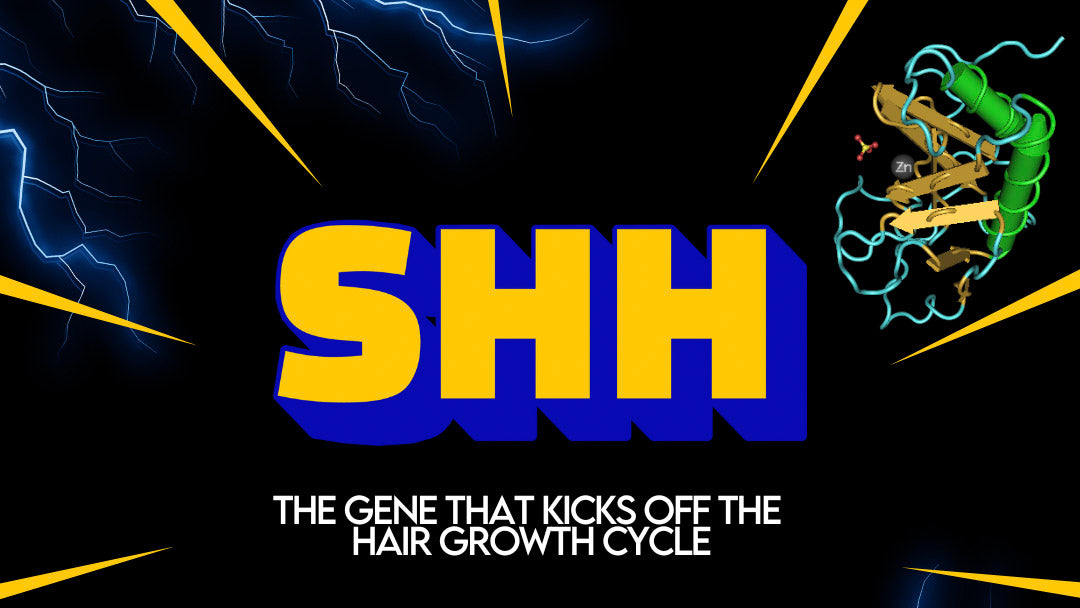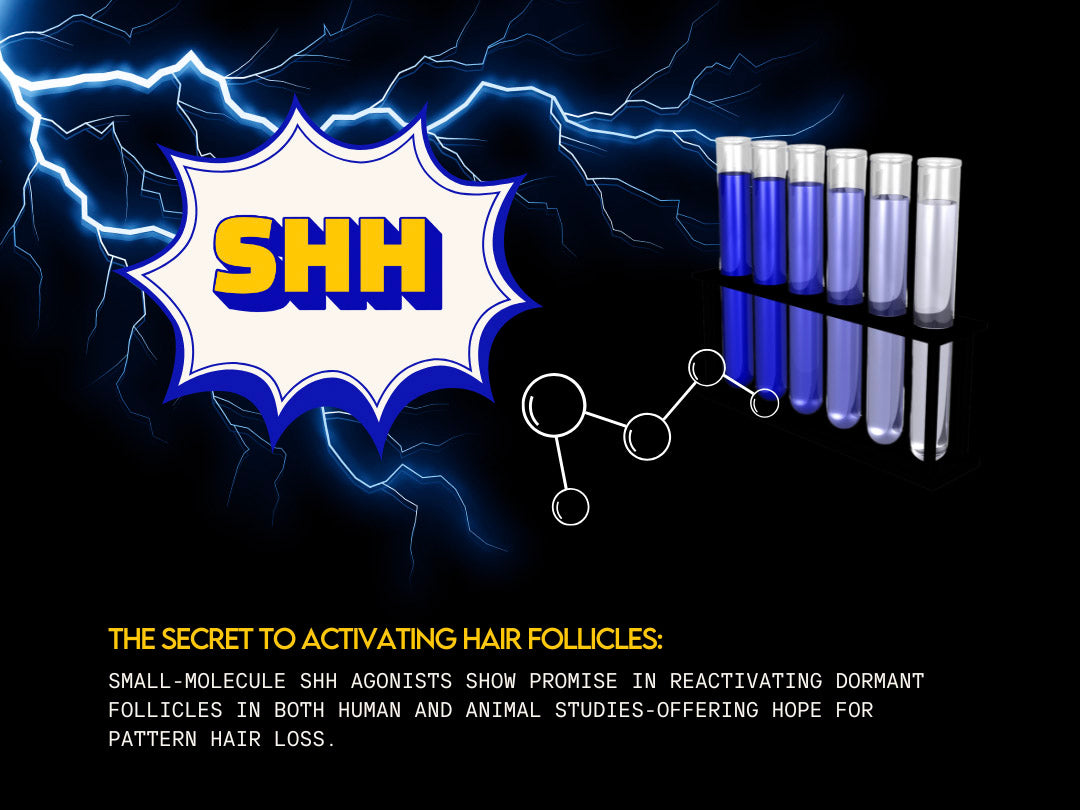Understanding the Sonic Hedgehog Gene: Hair Growth Insights

Introduction
The Sonic Hedgehog (SHH) gene helps control how our tissues grow and regenerate. It plays a key role in hair growth, especially in activating dormant follicles.
From Fruit Flies to Follicles: A Gene with Range
Originally discovered in drosophila melanogaster (fruit flies), the sonic hedgehog gene influences key functions in human biology like tissue repair and hair follicle cycling. Researchers are exploring how it reawakens hair follicles, especially during the anagen phase of the hair growth cycle. These functions are essential during embryonic development and extend to adult tissue regeneration.
The Bottom Line: SHH research began in fruit flies, but it’s helping solve human hair loss today.
What Is the Sonic Hedgehog Gene?
The sonic hedgehog gene is part of a gene family that includes Indian and Desert Hedgehog. It produces a protein that helps shape body structures like the brain, limbs, and skin. It has an important role in animal development and nervous system patterning, particularly in the neural tube and spinal cord.
In hair biology, it controls how follicles form and grow throughout life.
Bottom Line: SHH gives cells instructions for building and repairing structures, including hair follicles.
Interesting Fact: The sonic hedgehog gene was named after the Sonic the Hedgehog video game character because fruit fly embryos with mutations looked spiky.
Quick Science Glossary: Gene, Protein & Signaling—Made Simple
-
Gene: A set of instructions your body uses to build and repair itself. Think of it like a recipe stored in your cells.
-
Protein: The finished product made from that recipe. Proteins do the actual work—building structures, sending messages, or triggering changes in the body.
-
Signaling Pathway: A chain reaction of messages between cells. One protein activates another, which activates another—like a line of falling dominos—until the message (like “start growing hair”) is delivered.
🧬 In the case of SHH, your cells use the SHH gene to make the SHH protein, which sends a signal telling hair follicles to wake up and grow.
How Does the SHH Signaling Pathway Work?
The production of Sonic Hedgehog protein begins in the endoplasmic reticulum, where it undergoes post-translational modifications essential for its signaling function. This production phase is tightly regulated to ensure the right amount is secreted and activated at the right time.
SHH protein signals start at the cell surface and move inward. They influence genes that control cell growth and regeneration.
Step-by-Step: How SHH Sends Its Signal
-
SHH is made and processed using specific amino acids.
-
It binds to a receptor called PTCH1, lifting a block on another protein called Smoothened.
-
Smoothened moves through the cell membrane and activates internal messengers.
-
These messengers (GLI proteins) act as transcription factors, turning on genes that affect stem cell activity and hair growth.
The Bottom Line: SHH works like a message delivery system telling hair cells when to grow.
Interesting Fact: The strength of the signal depends on how far a cell is from the SHH source—this is called a concentration gradient.

SHH in Hair Follicle Development
During early development, SHH controls how hair follicles form and how deep they grow into the skin. It is highly active in the developing embryo, particularly in patterning the central nervous system and structures derived from the neural plate.
SHH Mutation: When Signals Go Awry
A mutation in the SHH gene can disrupt normal signaling, leading to issues in hair follicle development and other body systems. These mutations have been linked to conditions like nonsyndromic holoprosencephaly, limb abnormalities, and dental defects such as solitary median maxillary central incisor.
Studies show that animals missing the SHH gene lack normal follicles, supporting its essential role in follicular architecture.
The Bottom Line: SHH tells the body where to put hair follicles and how to build them.
Interesting Fact: Mutations in this gene can affect not just hair, but teeth and fingers too —sometimes caused by SHH mutation—
SHH in the Hair Growth Cycle (Anagen Phase)
SHH reactivates each time the hair follicle enters the anagen phase, or growth phase. It helps restart the cycle by:
-
Activating stem cells
-
Encouraging blood flow
-
Strengthening follicle roots
The activity of sonic hedgehog in these cycles is tightly regulated by negative feedback mechanisms that prevent overactivation.
The Bottom Line: Without SHH, hair follicles stay dormant.
Interesting Fact: SHH is one of the few molecules that must be reactivated every time a hair grows.
SHH & Hair: What You Inherit—and What You Influence
While SHH plays a critical role in hair growth, you don't simply “inherit” hair loss from this gene alone. Unlike rare conditions caused by full SHH mutations, most people have a working SHH gene—but it may be more or less active depending on your genetic variations and how your body regulates it.
You may inherit a version of SHH (or related genes) that’s less efficient at turning on the hair growth cycle—or one that’s easily disrupted by inflammation, stress, or hormonal shifts.
Even more importantly, how your body uses the SHH gene is influenced by lifestyle. This is where epigenetics comes in—factors like diet, stress, and inflammation can affect how strongly the SHH signal gets turned on, regardless of the DNA you're born with.
Bottom line: Your genes set the blueprint, but how your body reads and uses that blueprint can change—and so can your hair.
Beyond Your Genes: How Epigenetics Shapes Hair Growth
Genes like SHH give our cells a blueprint—but epigenetics decides how that blueprint gets read.
Epigenetics refers to chemical tags and signals that can turn genes “on” or “off,” or change how strongly they’re expressed. These changes don’t rewrite your DNA, but they affect how your body uses it.
Everything from stress, diet, inflammation, hormones, and even plant compounds can influence epigenetic signals—making a gene like SHH more active or more suppressed.
That’s why two people with the same gene might see very different results in hair growth—it’s not just about the genes themselves, but how they’re regulated.
Botanical Effects on SHH Signaling
Research shows that certain natural compounds may influence SHH signaling in both direct and indirect ways:
-
Curcumin (from turmeric) inhibits the SHH pathway by suppressing the expression of SHH-related transcription factors in medulloblastoma cells, leading to reduced signaling intensity (Goel et al., 2010).
-
Ginsenosides in ginseng are thought to activate SHH-related pathways by enhancing GLI1 activity, a key SHH transcription factor.
-
Rosemary oil, sage, and pumpkin seed oil have been shown to reduce inflammation and support circulation—conditions favorable to SHH expression and follicle activation.
-
Cinchona succirubra bark extract, rich in quinine, has demonstrated antioxidant and circulatory benefits, which may contribute to a supportive environment for SHH-mediated follicle regeneration.
-
Nettle (Urtica dioica) has shown anti-androgenic properties and early evidence suggests it may modulate signaling proteins, including those in the HH pathway, through its impact on inflammatory cytokines and local hormone balance.

These botanicals likely work by modulating upstream signals that influence the activity of sonic hedgehog, potentially aiding in stem cell recruitment or reducing inhibitory stressors that block SHH reactivation in hair follicles.
The Bottom Line: Some plant compounds may help wake up hair follicles by supporting or balancing SHH signaling.
SHH in Hair Loss Research
Disruptions in the production of Sonic Hedgehog can impair follicle regeneration and are an active area of investigation in regenerative dermatology. Regulating this production accurately is key to balancing growth without overstimulation.
Scientists are exploring how to use SHH safely in hair loss therapy. It's a delicate balance—too little leads to thinning, too much can cause unwanted growths.
Tools that boost SHH include:
-
Microneedling
-
Platelet-rich plasma (PRP)
-
Botanical therapies with measured effects on hh genes
The Bottom Line: Carefully supporting SHH may help regrow hair—without triggering side effects.
Leading Scientists Behind SHH Discovery
Notable researchers include Robert Riddle, Cliff Tabin, and Philip Ingham, who first described the gene in the early 1990s. Many of them were postdoctoral fellows at the time and helped define key gene names related to embryonic development.
Interesting Fact: The first tests were in mice and fruit flies—and are still used to study mouse sonic hedgehog and human sonic hedgehog activity in the lab.
SHH and the Central Nervous System
Shared Blueprints: Hair and Brain Development
In addition to its role in skin and hair, the sonic hedgehog gene is essential for patterning the central nervous system. During early embryonic development, SHH helps guide the formation of critical structures, such as the endoplasmic reticulum, which processes SHH proteins for signaling.
Its expression is vital in the developing embryo, particularly for establishing regions like the neural plate, from which much of the brain and spinal column arise. This overlap between neural and follicular patterning suggests a shared evolutionary architecture in tissue repair and regeneration.
The Bottom Line: SHH is not just for hair—it’s a master architect for body and brain.
Interesting Fact: The same pathways that help organize your brain during development may help reboot your hair growth later in life.
SHH Beyond Hair: Clinical Implications and Genetic Conditions
Research into gene sonic hedgehog has uncovered links between SHH signaling and several health conditions. For example, a mutation in SHH may result in nonsyndromic holoprosencephaly, where the forebrain fails to properly divide. Others may develop extra digits or tooth anomalies.
Many of these outcomes reflect the most severe form of SHH disruption. While such conditions are rare, they highlight the importance of precise control of this pathway. Ongoing studies in the United States and globally aim to clarify how variations in SHH expression affect different parts of the body.
Conclusion
The sonic hedgehog gene is essential for forming and reactivating hair follicles. It works like a molecular switch that turns on when hair is ready to grow. Its functions extend well beyond the scalp—impacting the nervous system, craniofacial development, and more.
Botanicals may influence this pathway naturally, offering new hope for science-backed, plant-based hair support.
Want to support SHH signaling naturally?
The Sempre Hair Growth System is formulated by physicians with ingredients like rosemary (hair growth foam), cinchona succirubra bark (shampoo, conditioner and foam) nettle, pumpkin seed and turmeric (Sempre hair growth organonutrients)—botanicals studied for their potential influence on hair growth pathways like SHH.

🧬 Shop Sempre Hair Growth System: Where nature meets science—starting at the root.
Sources
Elamin MH, Shinwari Z, Hendrayani SF, Al-Hindi H, Al-Shail E, Khafaga Y, Al-Kofide A, Aboussekhra A. Curcumin inhibits the Sonic Hedgehog signaling pathway and triggers apoptosis in medulloblastoma cells. Mol Carcinog. 2010 Mar;49(3):302-14. doi: 10.1002/mc.20604. PMID: 20025076.
The Advancement of Herbal-Based Nanomedicine for Hair
Padule, K.; Shinde, S.; Chitlange, S.; Giram, P.; Nagore, D. The Advancement of Herbal-Based Nanomedicine for Hair. Cosmetics 2022, 9, 118. https://doi.org/10.3390/cosmetics9060118
Chiang C, et al. "Essential role for Sonic hedgehog during hair follicle morphogenesis." Genes Dev. 1999. PubMed PMID: 10421633
Sato N, Leopold PL, Crystal RG. "Induction of the hair growth phase in postnatal mice by topical application of a sonic hedgehog agonist." J Invest Dermatol. 1999. PubMed PMID: 10594734
Zhao J, et al. "Ginsenoside Rg1 induces hair regeneration through activation of the sonic hedgehog pathway." Exp Mol Med. 2017. PubMed PMID: 28112155





Leave a comment